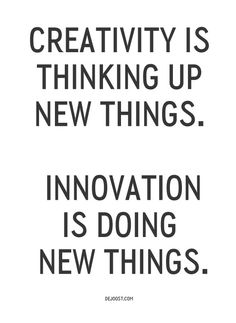Innovation.
We all love it, want it, speak it, eat it, and it feels good when something we do is affirmed as innovative by others, especially those we admire. Sometimes, though, and perhaps often, when we don’t hear such affirmations, we create our own. We cite our own work as innovative.
However the recognition of our innovative work manifests, the cynic inside of me does wonder from time to time if our desire to be innovative gives birth to claiming innovation in much of the work we do. That cynic inside of me has wondered the same about me on occasion; just mention that to suggest that my inner cynic has no qualms about digging in on me, what I think, and what I do (and don’t)
What it is?
A common definition of innovation is this: a new method, idea, product. I think other words go here, too, like a new service, device, or structure. Feel free to add more
Synonyms often cited include: change, revolution, departure, introuction, variation, transformation, upheaval, and alteratio.
Okay, so far so good. I see innovation having such words point to its meaning. The real challenge for me is understand how it begins, what happens when it happens, and when and how it transitions into something else.
I have some trouble with the idea that innovation can be associated with an idea. It’s not that we can’t muster up innovative ideas, but if those ideas just float about like dandelion fluff but never land on the ground, do they qualify as innovative?
Why I ask is that I see innovation as existing when it is put into action through new ways doing things or building things. In other words, an innovative idea about a program that does not seed itself in the program seems incomplete to me. So, if innovation can be a new idea I am suggesting that if the idea fails to consummate with actions, it is unrequited.
However, the math cannot just be, new ideas + new actions = innovation.
By itself, that formula says nothing about the quality or impact of the actions. I mention this because most of us seem to equate innovation with good stuff. After all we don’t go about saluting innovations that harm people, do we

Values need to be a part of the formula it seems. But so does intent. We don’t set out to innovate without intent, do we? We don’t sit down with others and say, let’s innovate. If we did, some one would invariably say something like, innovate about what?
Values are shifty sometimes. Example: I see innovation as producing a new action that is helpful, good for people, and so on. I have a hard time saluting those who create new weapons because I associate weapons with doing harm. Others will not agree – in particular, weapon makers and militaries. They value weapons because they protect us from others. The more we have the better the deterrence, right?
My stance on weapons is in tact, but I can’t limit innovation to that which fits my association of it with doing good. Innovation, itself, has no morality. The people engaged in it do and I don’t have to write another blog post to convince you that on questions of morality, human beings have no “same page” to reference.
So, let’s expand the definition: values + intent + new ideas + new actions = innovation.
Better?
I think so. But. Not there yet.
What about obstacles? What about process? What about tools? And what about that which prompts us to seek something other or more than we have now? When I think about what gets my innovation juices going, I think about two drivers: aspiration and/or discontent.
Aspiring innovation is about seeing a future that is better than what is with us right now. It’s different from intent, which is really about what we intend to do in “this innovation” to move us toward the aspiration. The latter is bigger and broader than the former.
There are times, though, when discontent with the status quo is the spark. While discontent does imply that there is an accompanying aspiration (and vice versa by the way), my sense is that one of the two is more predominant at the onset of an innovative quest.
Man, I have made defining innovation via a mathematic formula rather complex. I should also mention that my math skills are basic. Great at basic math and I can write a few Excel formulas, but truth is anything beyond that is boggling.
Anyway. Here goes:
values + (aspiration and intent) + process + (new ideas and process)
+ (tools and process) + new actions = innovation
I know. You will see what is missing or question the structure of the formula. This is my straw dog definition. I welcome your ideas, even a brand new formula.
Hmmm.
My invitation to you to enter the fray of defining innovation is an invitation to collaborate. Likely all innovation involves that. See, already, I see something to integrate into my straw dog.
Hope to hear from you.
I am going do another blog post about what happens when innovation happens, and if I do that, it won’t be long before the third and last instalment — about when and how innovation transitions into something else, which it always does.
Doesn’t it?





